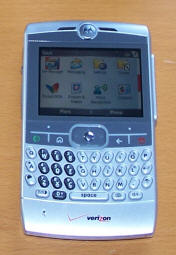RIKLBLOG
|
| Tomorrow |
| 05 Jan. 2007 |
| Yesterday |
| Index |
| Eventide |
| SETI League |
| PriUPS Project |
| Bonus! |
| Contact |

RIKLReviewTM - Motorola Q "Smartphone"
Part 2, The Pictures And Telephone Features
We broke for some grooving (but not bopping) yesterday and now we're back to discuss...
Pictures on the Motorola Q
Unlike the MP3 player, which I use actively, I wanted a camera because sometimes you just have to take a picture and you can't do it with the camera you left at home. I paid less attention to the specifications of the Qs camera (1.3 megapixel, and little else). I agreed I'd be satisfied with a "decent" camera, and that's what I got.
In addition to the Guck? blogitem, for which the photos were taken outdoors, I just tried an experiment. I took a picture of an old but satisfactory 1.3 megapixel camera that I no longer use but which did a fine job before I replaced it with the Kodak, which I love. Because I have nothing but derision for "digital zoom," I used the Q to take four pictures, one at each of its different zoom ratios (1, 2, 4, and 6) from exactly the same distance from the subject. I then cropped the photos so that the same field of view was in each. Let's discover the results together:
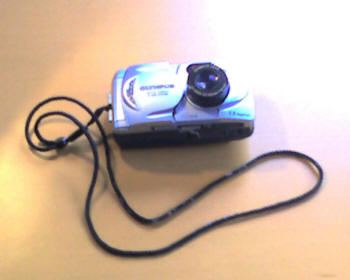 Zoom = 6 |
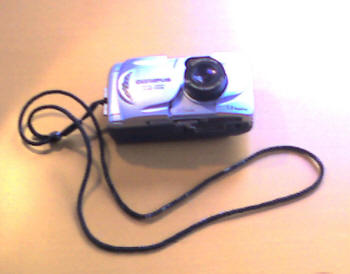 Zoom = 4 |
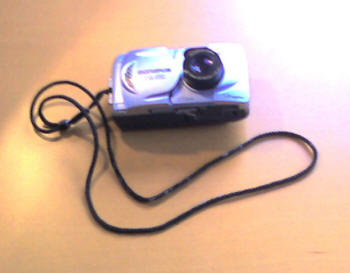 Zoom =2 |
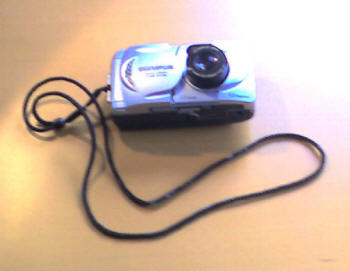 Zoom = 1 (none) |
All pretty similar, eh? I guess the "digital zoom"
just restricts the field of view rather than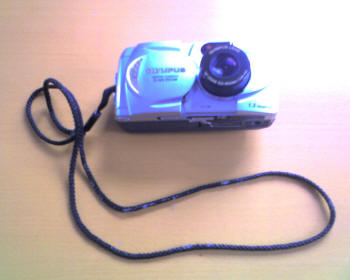 improves the resolution. Let's have taken a picture using "optical
zoom," i.e., closer to the subject. Manifestly better, still not
great. But it is a photo, and far better than any drawing I could
assay. I've been reading about a number of new developments
in cellphone lenses, including continuously variable optical zoom and,
of course, more pixels.
improves the resolution. Let's have taken a picture using "optical
zoom," i.e., closer to the subject. Manifestly better, still not
great. But it is a photo, and far better than any drawing I could
assay. I've been reading about a number of new developments
in cellphone lenses, including continuously variable optical zoom and,
of course, more pixels.
There are no adjustments on the Q as you might find on a real camera; no f-stop, shutter speed, balance, or any of the myriad features that delude people into thinking they're real photographers (or even talented amateurs). Instead, you point it, try to hold it steady, and shoot. You hear a puny, mock-shutter sound, and a second later see a picture on the screen. I always leave the zoom set at one, i.e., no magnification, because I get more stuff in the picture that way with no degradation in quality that I've noticed. In each case this has resulted in a photograph whose quality varied from satisfactory to unrecognizable. So it goes.
I must point out one bizarre misfeature of the Q's camera section. It has a "Flash" which can be turned on or off by a menu. Now, the word "flash," especially in terms of photography, has a common meaning: When you take the picture, it creates extra illumination to improve the exposure. But the Q has decided that "Flash" means "flashlight." When you turn the flash on, a bright white LED comes on and stays on until you use the menu to turn it off again. Not that this isn't valuable when descending a dark stairwell, which can happen once in a lifetime, but it serves little purpose for photography. For one thing, it isn't as bright as it might be if it were briefly pulsed, as much greater power can be delivered to an LED if it's only done for milliseconds. For another, it must drain the Q battery much more quickly when on. It was thoughtful of Motorola to provide a flashlight, but would it be too great a challenge to add a third menu item after "Flash," i.e., "Flashlight" and return "Flash" to its correct meaning? I was so incredulous when I discovered this misfeature that I called Motorola customer service to find out if my Q was defective. "No, that's normal," I was told.
A one sentence summary: The Q has a camera, which is far better than its not having a camera. (I haven't accidentally neglected to mention the video function. It's deliberate. I haven't even tried it.)
Telephony on the Motorola Q
I can talk to people; they can talk to me. I mostly compared the Q to my previous cellphone, the Timeport. I haven't noticed any difference in quality or sensitivity. I was satisfied with the Timeport, I'm satisfied with the Q. After all the babble about the camera and MP3, I intend to be relatively brief here. I don't make a lot of calls and I don't encourage people to call me on the cellphone.
Cellphone quality in general is poor. This is not a criticism of the Q—all phones use a standard algorithm whose purpose is to conserve network bandwidth and yet be good enough to prevent destruction of the phone at the hands and heels of angry users. The old standard for landlines used to be "toll quality" and I would be thrilled if that were met by cellphones, but it isn't, regardless of model, cost, or features. In fact, this is a great opportunity for Motorola and Verizon. I was able to use the Q as a PC modem at about 200Kbps. This is easily enough for spectacular voice quality. I think it would be great for the cellular providers to consider an adaptive bandwidth scheme. Certainly there are times when the network is busy and the old standard will have to suffice. But what's to stop Verizon from deciding that a call I make at midnight can't go over the high-speed network instead? Lethargy, standards, and maybe even legitimate technical reasons. I'm no expert, but I can softly dream.
I originally had a major problem with the voice recognition on the Q and whined about it mightily. With the Timeport, one had to "train" the unit by recording a contact name. If I wanted to call "HOME" I would record "HOME" and then it would compare what I said with the recording. If it matched, "HOME" is what I got. The Q has a different system. It is technologically brilliant! Instead of requiring training, it guesses which contact you are calling by comparing what you say with how it feels contact names should be pronounced. As brilliant as it is, it has a downside: You have to say the full name of the contact, first and last, to have a chance at recognition. I found this to be true even if I only had a couple of contacts loaded. I would rather be able to say what I want and have it recognized. However, the Timeport only allowed a small number of voice recordings for contacts. Presumably the Q allows an indefinite number. If it finds an ambiguity or multiple numbers for a contact, it requires you to select the correct one, either by voice or by joystick. While I personally prefer the "training" scenario, I can see where the Q is an advance, especially if one has many contacts, so I retract my whine, and issue several grudging but genuine nerd-respect-points to the Q's ability to do untrained voice recognition at all.
One problem I'm still having is "pairing" the Q with the Prius, which has a native Bluetooth feature. Although I can make calls, I can't seem to dial using the car "phonebook." The one entry I sent from the Q to the Prius appears perpetually "greyed out" for reasons unknown. This needs further investigation; I mention it for completeness only.
By far my favorite feature of the Q's cellphone persona is the downloadable ring tone. You can create a sound and associate it with a caller, allowing you to tell who is calling just by the ring. This was one of the first things I tried. What sounds did I select? What else? Now if only someone would call me...
Size
 Here's a comparison between the old Timeport and the new
Q. Other than width, which is necessarily greater to accommodate
the qwerty keyboard on the Q, the Timeport, duct tape and all, is larger
in the other dimensions. In particular it is about twice as thick.
First the credit: I am astonished at how well-engineered the Q is. I'm sure the team was offered $100,000 for every millimetre they shaved off, and did they ever earn that money! Now the "suggestion." Why bother? The height and width are pretty much what they have to be. What's the point of making it so thin? We're putting it in our pockets or belt pouches, not in a toaster! Would it hurt if it weighed a few ounces more? By increasing the thickness by a factor of two, it would be about the same thickness as the Timeport or as my Creative Zen MP3 player and still thinner than the Archos MP3. That double thickness could hold a battery with 10x the capacity of the current one! AND maybe 20GB of flash memory OR a 60GB hard drive. Third party manufacturers: I raise my hand as a candidate customer! |
Summary
Dream on, Richard. Motorola won't double the thickness. Maybe Apple will have enough sense to do what I want? Too late for a while, of course. I had to get a "plan" and sign a "contract" to get the Q. And, whining aside, it has been a fun toy to explore. It just isn't exactly what I want. I have faith that a better camera and a more capable MP3 player in combination with a cellphone will be with us soon.
The Q has a vast number of features and capabilities I haven't explored or considered. I believe there's a world of external downloads of which I can partake now that I've made the decision to keep the Q. I may even find a software development kit. The Q, as most devices, would be a better product if Motorola had consulted me before releasing it. A trivial fix: When the phone is "locked," pressing any key causes the backlight and display comes on for a second so you can see whether any messages are waiting. Whoops! Not if the battery has just been fully charged! Then you have to unlock the phone, dismiss the "charged" message, and re-lock it. Do we really need a full-screen "charged" message? And, speaking of trivial, with all the stuff it does do, I would have been thrilled to see a complete scientific calculator included, where I could type in my sines and cosines and have the auto-complete feature finish my formulae. But I'm not surprised or disappointed that they didn't include this specialized function. What does surprise me is that the single most useful program ever, a simple four-function calculator, is nowhere to be found. (Or if it is to be found, perhaps it's mentioned in the Spanish portion of what passes for a manual.)
Everything Else
My Q and I will probably be living together for the next two years. Verizon does pro-rate their termination fees, so it's not out of the question that I will move up to a better unit if one should appear sooner, as I hope and expect. Two years or a good fraction thereof should be enough to discover a lot of the other capabilities of the Q. Perhaps I'll make an "appointment" to have "lunch" or make a voice memo to have Miss Hodgkiss bring me the Emerson Account just to see if I can figure out how. I've used the Q's mobile Internet Explorer to download issues of my blog and especially to show some of the photos. It works surprisingly well and I have mentioned that I like the display. I wish there were "sync" possibilities for something other than Microsoft Outlook, which I have only on one laptop I inherited and which I rarely use. Fortunately, you can transfer files between PC and Q without Outlook being present.
Perhaps this will turn into a hyperlink to the next Q extravaganza after I've had more time to play with the other features. But now it's time to drop the Q for a while (which I've already done without damaging it) and go on to consider more blogitems. Perhaps next week we'll decide what the monthly cost of a human child should be.
|
Follow-up 16 January 2007 |
I did find the 4-function calculator today, while browsing at random through functions I hadn't checked before. I also started looking into how I could write my own programs for the Q. Motorola has a site devoted to this, and it looks like standard Microsoft software allows it to be done.
NP: "Slainte Mhath" - Marillion
| © 2007 |
| Richard Factor |
